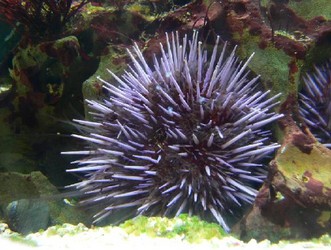

Purple Sea Urchins are beautiful creatures and are known for their numerous spikes which aid with locomotion as well as protection. Strongylocentrotus purpuratus. © David Monniaux
When two years of age
January, February, March each year,
They breed by releasing gametes into the ocean,
It all depends on the surf, it appears,
If it's violent, the gametes cannot survive because it’s all in the motion.
But, if they survive, they can start their life, a new page.
Algae is their food,
“Grazers of the marine algae”: they have been named,
Their duty is to maintain the amount of algae when in the mood,
They have a role as an herbivore, as proclaimed
And they enjoy eating kelp
During tidal waves, the kelp are washed away,
The purple sea urchins eat the young kelp who cry for help.
When there are none left, the urchins must pay.
These species is common, in the present,
But, in the future, they might be in danger,
In Japan, people find sea urchin sushi quite pleasant
The Department of Fish and Game are trying to help these strangers
These creatures are harvested at fisheries in a beat,
Other species enjoy eating their food: us
We are taking all we can plus…
We are leaving them with nothing to eat
Purple sea urchins are found in shallow parts
Specifically on a coast with strong waves,
They are unlikely to be apart
One can find them on the east coast of America
As well as on the Pacific coast, according to the editors
Sheep-head fish, spiny lobster, otters are their predators
However, they are brave
They use their spikes
And they continuously put up a fight
These spikes are also used for mobilization
What an idea, a sensation.



 Go to quick links
Go to quick search
Go to navigation for this section of the ToL site
Go to detailed links for the ToL site
Go to quick links
Go to quick search
Go to navigation for this section of the ToL site
Go to detailed links for the ToL site